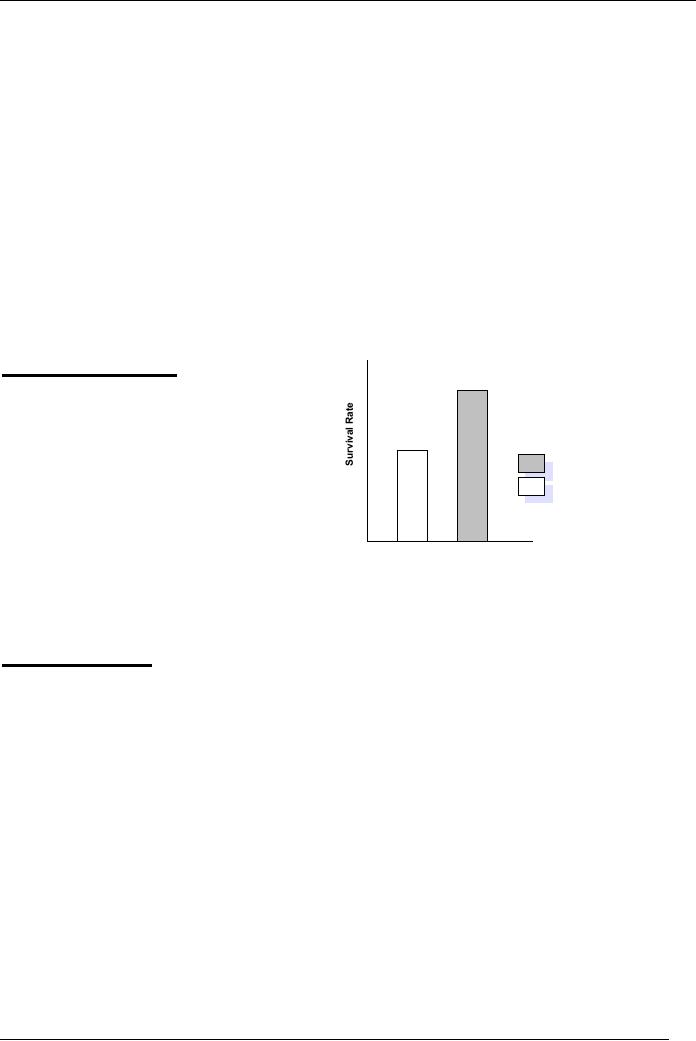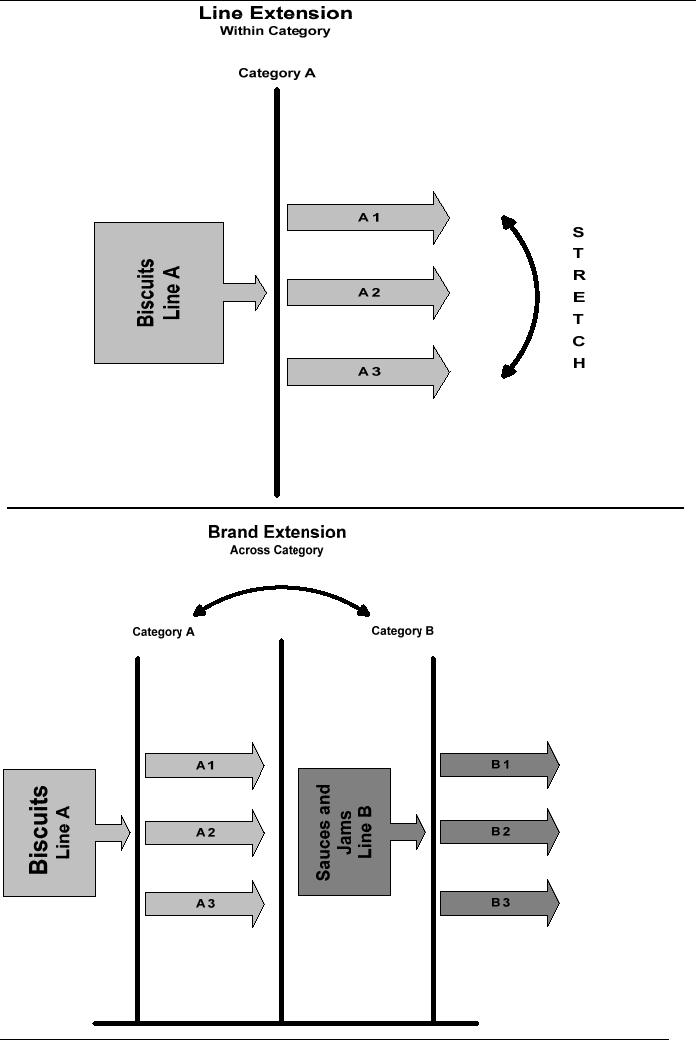 |

Brand
Management (MKT624)
VU
Lesson
21
BRAND
EXTENSION
Introduction
With
an understanding developed on
positioning, this lecture
takes us into the area of
brand
extension.
Although loosely used, the
term brand extension comprises of
two sub areas
line
extension
and brand extension. The
latter is generally used in
all situations of
extensions,
diversifications,
or stretch. We have to draw a
distinction between the two
for a clear
understanding
of the concepts.
Concept
of positioning clarifies that
not one position can satisfy
all the varying needs
within
the
category. Different needs
have to be identified toward
their fulfillment. To keep up
with the
evolution
you have to evolve new
points of difference. Different
needs refer to
different
segments
and every product has its
variants to address to those segmental
needs. This holds
true
for
consumer consumables as well as consumer
durables. Regular and mild cigarettes,
regular
and
fruit yogurt, regular and
high fiber cereals, regular and
low cholesterol margarine,
and
economy
and executive models in cars
are all examples of product
variants in different
segments
and categories.
To
let the market know
that you have something
different to offer, you must
differentiate
between
the existing offering and
the new entry. For
the new entry meant to
address a different
need,
you must create a different
image reflecting the new
promise and must have an
evolved
contract
in place. You do that in either of the
two ways:
A.
Staying within the value
framework of the original
brand, meaning under the
same brand
name.
You do not go too far away
from the core
identity.
B.
Create a different identity
altogether, meaning a new
stand-alone brand.
Brand
extension
Brand
extension is all about the
existing brands. As the terminology
suggests, we do something
with
the existing names for
the new offerings. Brand
extension, therefore, is the
study and
practice
of deciding
1.
What
to do in situations that evolve
with changing needs? Examples
could be cited of
soups
coming into different
flavors, biscuits in different
tastes and packs, and detergents
in
powder and liquid
forms.
2.
What
to do in situations that offer an
opportunity to enter a new
market altogether?
Examples
could be furnished about
manufacturers of juices getting
into milk and yogurt,
tea
getting into soups, chocolate
getting into ice cream, and cameras
into photocopying
machines
etc.
Let's
be clear that we are
discussing both situations in
relation to using our
existing brand name
that
is strong. One situation relates
getting into variants of the
existing product, while
other
involves
going across the existing
business lines into new
ones. Both have a common
factor
and
that is the same
brand name. We use
the same brand name because
it is strong!
Leveraging
The
opportunity of using the
same brand name for variants
or altogether new products
takes us
into
the domain of leveraging
adding value to the company
by capitalizing on the brand as
an
asset.
Temptation to do so is always huge. We
keep the same brand name so
that customers can
develop
an immediate familiarity with
the new introductions
variants or new products.
And
that
is what leveraging is all
about!
Managers
feel the need to leverage
their brands under the
following two different sets
of
circumstances:
81

Brand
Management (MKT624)
VU
�
When
they are led into
genuine situations of satisfying
evolving needs, they feel
rightly
driven
to leverage the brand by
introducing its variants
light cigarettes and sugar-free
chewing
gum fall under practice 1 of
brand extension discussed
above.
�
When
it is attractive to go across category,
managers do that with the
confidence that their
existing
brand name is going to add
value to their new
introduction and will become
popular
immediately. This relates practice 2 of
brand extension.
Leveraging
without purpose
If
managers attempt to leverage
their brand only because it
has high value but it
does not really
have
a specific need to satisfy,
then the managers are
wandering into the marketing
no-man's
land
and end up introducing something with no
substantive difference. It is merely an
exercise
toward
brand proliferation!
This
means that brands should be
seriously treated as extremely valuable
properties and not
subjected
to meaningless extensions with minor
differences. Over-proliferation is a
serious
threat
to a brand's future. Customers
show resentment to brands with no
real point of
difference1.
Rate
of Survival after 3
Years
Figure
24
Why
brand extension?
50%
Brand
extension is on the rise.
Most of the
new
product launches take place with
the
existing
strong brand names. Cost
of
30%
launching
a new brand in three
major
Existing
Brands
markets
(US, Europe, and Japan is
about
New
Brands
US$
1 billion), whereas launching a
product
under
the same name is a fraction of
that
cost.
It is estimated to be one fifth2.
30%
of new brands survive just
about three
Brands
years,
but the rate goes up to 50%
if
launched
under an existing brand
name3.
Brand extension, therefore, is
cheaper and securer. It
looks
like a sure way to gain
market share and produce
visible results.
Kinds
of extensions
There
are two kinds of extensions,
namely line extension and
brand diversification.
Brand
diversification
is in effect brand extension,
but this terminology of
brand extension somehow
is
used
generically for both types
of extensions. You have to make an effort
not to be confused by
this.
Line
extension
Line
extension is basically getting
into different versions of
the same base product on
the same
market.
A manufacturer of spices getting
into more non-traditional
spices or recipes and a
cheese
manufacturer getting into
different kinds of packing,
portions, slices, and boxes to
appeal
to different target audiences
are examples of this
phenomenon. The objective here is
to
add
more depth to your offerings
within a definite market.
Line extension corresponds to
practice
1 of brand extension discussed in
the beginning of the
lecture.
Brand
diversification/extension/stretching
This
refers to stretching your
brand into new product
fields. Your brand becomes an
umbrella
covering
very different segments and
products. A few examples are
Mitsubishi, Philips, and
GE.
Mitsubishi includes shipyards,
nuclear plants, cars,
hi-fidelity systems, banks, and
even
food;
Philips includes electrical appliances to
lighting to sophisticated systems; GE is
into
82

Brand
Management (MKT624)
VU
aircraft
engines, electrical appliances, energy and
more4. They use one name
because that is a
direct
recognition of the fact that
their name is the real
capital of their company.
Brand
diversification
or extension or stretching corresponds to
practice 2 of brand extension
discussed
earlier.
It is real diversification toward
different product categories
and, hence, is a highly
sensitive
and strategic choice.
"Line
extension" and
"brand
extension" therefore
are two well differentiated
concepts that
must
be understood for the sake
of knowing how and when each
will have a perfect fit with
the
situation.
Both could be explained with
the help of two graphic
illustrations on the
following
page.
Line
Extension in detail
Extending
the line is an evolutionary
step in the life of a brand
and occurs to address
the
changing
needs. In the words of
Kapferer, just as human
species survive by adapting to
the
environment,
brands that start as single
products have to adapt to
the marketing environment
by
breaking
into sub-species5.
Toyota cars, Coca-Cola,
National and Shan "Masalas", LU
and
English
Biscuit Manufacturers' biscuit
brand variations are a few
examples that clarify
the
whole
concept.
Forms
of line extension
It
takes on the following
forms6:
�
Multiplication
of formats and sizes. It is
typical in cars, soft
drinks, cakes, and
biscuits
etc.
�
Multiplication
of variety of tastes and
flavors. Yogurt,
juice, and milk are
excellent
examples
of this form.
�
Multiplication
of the type of ingredients.
Caffeine-free coffee and sugar-free
juice fall
into
this form.
�
Multiplication
of generic forms of medicines. For
headache, a pharmaceutical
company
may
introduce extra-strength, without
drowsiness, no-allergy formulas
etc.
�
Multiplication
of physical forms. Detergents
in powder and liquid; deodorants in
sticks,
spray,
and roll-ons are perfect
examples.
�
Multiplication
of product add-ons satisfying closely
related needs of the
same
consumer.
Mascara,
lipstick, skin-care creams by one
company and deodorants, shave
cream,
gel, and soothing balm by
another are examples of this
form.
�
Multiplication
of versions having a specific
application. Shoe cream
for regular leather,
powder
or spray for suede leather
polish for wooden
furniture and polish for
marble top
to
give a few examples.
83

Brand
Management (MKT624)
VU
Figure
24
Figure
25
84

Brand
Management (MKT624)
VU
Positive
side of line
extension
As
said earlier, each brand
starts as a single product and with
the passage of time becomes
sub-
divided
into variants that respond to
differentiated expectations.
1.
Increases Usage
Cola
drink is an example, the
multiplication of versions has
increased its consumer
base
in family size bottle, disposable
bottle, can, and returnable
bottles all are
directed
toward
increasing usage.
2.
Reinforces Sales
With
each version designed for
one particular usage mode, the
brand reinforces its
sales
with
a wider market base. With
product variants in the
categories of biscuits,
cheeses,
butters
and margarines, and packaged cakes,
you extend the market by
opening a
variety
of eating occasions.
3.
Friendly and Caring
It
shows sensitivity to consumer's
needs and the brand energizes
itself by responding to
those.
In doing so, it maintains an
interesting, friendly, and caring
character. A small
tub
of jam or a sachet of powdered
milk is an example.
4.
Pushes Boundaries
It
pushes the boundaries of the
market and strengthens the
brand's domination. It
increases
brand's visibility through
successive launches.
5.
Revitalizes failing
Brands
Line
extension helps ailing and
tired brands. It revitalizes many brands
by way of
introduction
of new offerings. Because of
the resilience brands have,
they bounce back
if
they are introduced with a
new fervor justified by a
meaningful point of
difference.
Brands
fail because of price
competition. It helps the
company launch another
version
with
a lower price.
6.
Maintain relationship between
market share and shelf-space
share
Knowing
that customer involvement in
consumer items is low, the
number of impulse
buyers
is increasing. Also knowing
that shelf space at the
retail outlet is limited, it
is
always
good to introduce something by the
existing name and keep competition
pushed
out.
Bibliography:
1.
Geoffrey
Randall: "Branding A Practical
Guide to Planning Your
Strategy"; Kogan
Page
(55)
2.
Geoffrey Randall: "Branding A
Practical Guide to Planning
Your Strategy";
Kogan
Page
(56)
3.
Geoffrey Randall: "Branding A
Practical Guide to Planning
Your Strategy";
Kogan
Page
(56)
4.
Geoffrey Randall: "Branding A
Practical Guide to Planning
Your Strategy";
Kogan
Page
(57)
5.
Jean-Noel Kapferer: "Strategic Brand
Management Creating and Sustaining
Brand
Equity
Long Term"; Kogan Page
(181)
6.
Jean-Noel Kapferer: "Strategic Brand
Management Creating and Sustaining
Brand
Equity
Long Term"; Kogan Page
(181)
Suggested
readings:
1.
Jean-Noel
Kapferer: "Strategic Brand
Management Creating and Sustaining
Brand
Equity
Long Term"; Kogan Page
(226-231)
85
Table of Contents:
- UNDERSTANDING BRANDS – INTRODUCTION:Functions of Brand Management, Sales forecast, Brand plan
- INTRODUCTION:Brand Value and Power, Generate Profits and Build Brand Equity
- BRAND MANIFESTATIONS/ FUNDAMENTALS:Brand identity, Communication, Differentiation
- BRAND MANIFESTATIONS/ FUNDAMENTALS:Layers/levels of brands, Commitment of top management
- BRAND CHALLENGES:Consumer Revolt, Media Cost and Fragmentation, Vision
- STRATEGIC BRAND MANAGEMENT:Setting Objectives, Crafting a Strategy, The Brand Mission
- BRAND VISION:Consensus among management, Vision Statement of a Fast Food Company, Glossary of terms
- BUILDING BRAND VISION:Seek senior management’s input, Determine the financial contribution gap
- BUILDING BRAND VISION:Collect industry data and create a brand vision starter, BRAND PICTURE,
- BRAND PICTURE:Brand Value Pyramid, Importance of being at pinnacle, From pinnacle to bottom
- BRAND PERSONA:Need-based segmentation research, Personality traits through research
- BRAND CONTRACT:The need to stay contemporary, Summary
- BRAND CONTRACT:How to create a brand contract?, Brand contract principles, Understand customers’ perspective
- BRAND CONTRACT:Translate into standards, Fulfill Good Promises, Uncover Bad Promises
- BRAND BASED CUSTOMER MODEL:Identify your competitors, Compare your brand with competition
- BRAND BASED CUSTOMER MODEL:POSITIONING, Product era, Image Era, An important factor
- POSITIONING:Strong Positioning, Understanding of components through an example
- POSITIONING:Clarity about target market, Clarity about point of difference
- POSITIONING – GUIDING PRINCIPLES:Uniqueness, Credibility, Fit
- POSITIONING – GUIDING PRINCIPLES:Communicating the actual positioning, Evaluation criteria, Coining the message
- BRAND EXTENSION:Leveraging, Leveraging, Line Extension in detail, Positive side of line extension
- LINE EXTENSION:Reaction to negative side of extensions, Immediate actions for better managing line extensions
- BRAND EXTENSION/ DIVERSIFICATION:Why extend/diversify the brand,
- POSITIONING – THE BASE OF EXTENSION:Extending your target market, Consistency with brand vision
- DEVELOPING THE MODEL OF BRAND EXTENSION:Limitations, Multi-brand portfolio, The question of portfolio size
- BRAND PORTFOLIO:Segment variance, Constraints, Developing the model – multi-brand portfolio
- BRAND ARCHITECTURE:Branding strategies, Drawbacks of the product brand strategy, The umbrella brand strategy
- BRAND ARCHITECTURE:Source brand strategy, Endorsing brand strategy, What strategy to choose?
- CHANNELS OF DISTRIBUTION:Components of channel performance, Value thru product benefits
- CREATING VALUE:Value thru cost-efficiency, Members’ relationship with brand, Power defined
- CO BRANDING:Bundling, Forms of communications, Advertising and Promotions
- CUSTOMER RESPONSE HIERARCHY:Brand-based strategy, Methods of appropriations
- ADVERTISING:Developing advertising, Major responsibilities
- ADVERTISING:Message Frequency and Customer Awareness, Message Reinforcement
- SALES PROMOTIONS:Involvement of sales staff, Effects of promotions, Duration should be short
- OTHER COMMUNICATION TOOLS:Public relations, Event marketing, Foundations of one-to-one relationship
- PRICING:Strong umbrella lets you charge premium, Factors that drive loyalty
- PRICING:Market-based pricing, Cost-based pricing
- RETURN ON BRAND INVESTMENT – ROBI:Brand dynamics, On the relevance dimension
- BRAND DYNAMICS:On the dimension of knowledge, The importance of measures
- BRAND – BASED ORGANIZATION:Benefits, Not just marketing but whole culture, Tools to effective communication
- SERVICE BRANDS:The difference, Hard side of service selling, Solutions
- BRAND PLANNING:Corporate strategy and brands, Brand chartering, Brand planning process
- BRAND PLANNING PROCESS:Driver for change (continued), Brand analysis
- BRAND PLAN:Objectives, Need, Source of volume, Media strategy, Management strategy